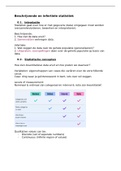Samenvatting
Sociologie Beschrijvende en Inferentiële Statistiek (BIS) Samenvatting
Ik heb alle modules van Jasper Muis op canvas helemaal overgetyped. Dit fungeert als een heldere samenvatting. Ik heb hier uiteindelijk een 7,5 mee gehaald.
[Meer zien]




